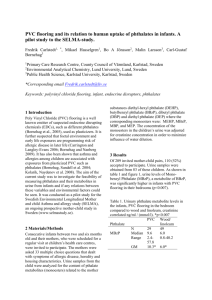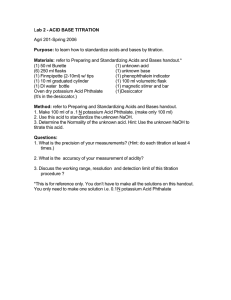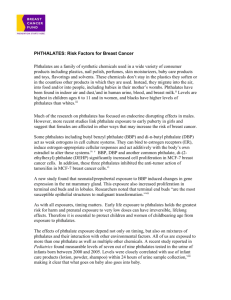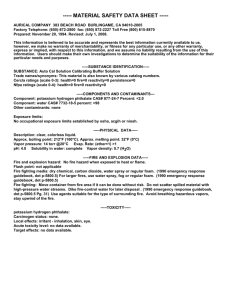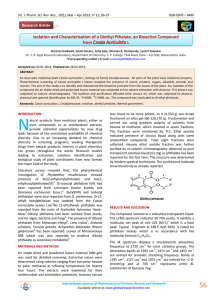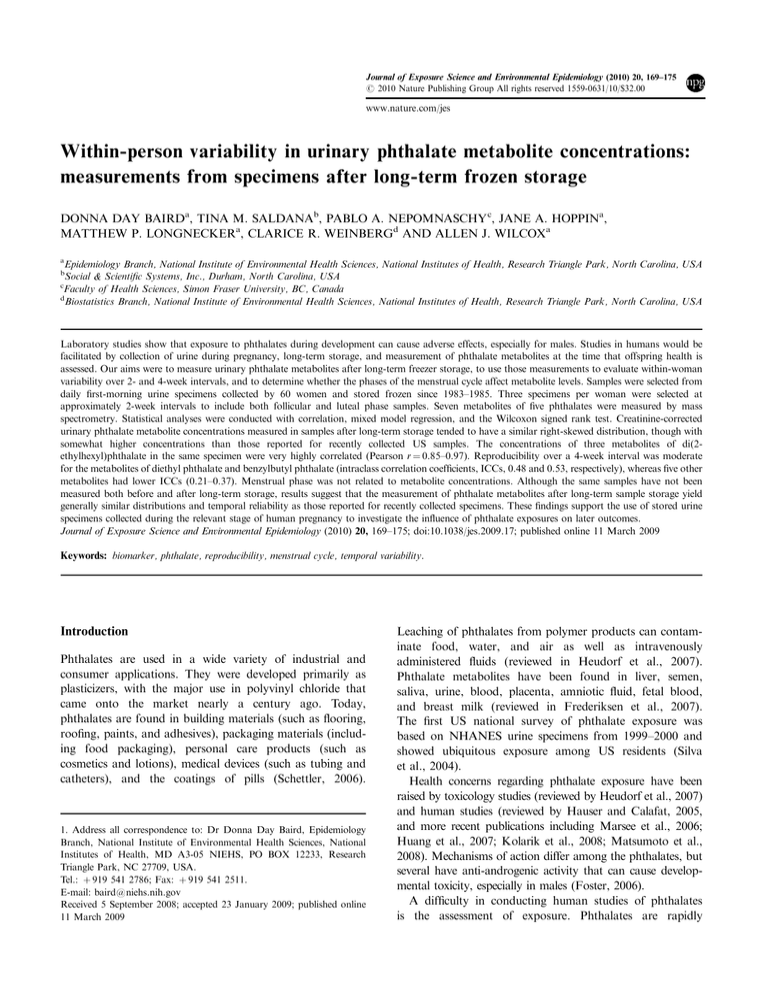
Journal of Exposure Science and Environmental Epidemiology (2010) 20, 169–175
r 2010 Nature Publishing Group All rights reserved 1559-0631/10/$32.00
www.nature.com/jes
Within-person variability in urinary phthalate metabolite concentrations:
measurements from specimens after long-term frozen storage
DONNA DAY BAIRDa, TINA M. SALDANAb, PABLO A. NEPOMNASCHY c, JANE A. HOPPINa,
MATTHEW P. LONGNECKERa, CLARICE R. WEINBERGd AND ALLEN J. WILCOXa
a
Epidemiology Branch, National Institute of Environmental Health Sciences, National Institutes of Health, Research Triangle Park, North Carolina, USA
Social & Scientific Systems, Inc., Durham, North Carolina, USA
c
Faculty of Health Sciences, Simon Fraser University, BC, Canada
d
Biostatistics Branch, National Institute of Environmental Health Sciences, National Institutes of Health, Research Triangle Park, North Carolina, USA
b
Laboratory studies show that exposure to phthalates during development can cause adverse effects, especially for males. Studies in humans would be
facilitated by collection of urine during pregnancy, long-term storage, and measurement of phthalate metabolites at the time that offspring health is
assessed. Our aims were to measure urinary phthalate metabolites after long-term freezer storage, to use those measurements to evaluate within-woman
variability over 2- and 4-week intervals, and to determine whether the phases of the menstrual cycle affect metabolite levels. Samples were selected from
daily first-morning urine specimens collected by 60 women and stored frozen since 1983–1985. Three specimens per woman were selected at
approximately 2-week intervals to include both follicular and luteal phase samples. Seven metabolites of five phthalates were measured by mass
spectrometry. Statistical analyses were conducted with correlation, mixed model regression, and the Wilcoxon signed rank test. Creatinine-corrected
urinary phthalate metabolite concentrations measured in samples after long-term storage tended to have a similar right-skewed distribution, though with
somewhat higher concentrations than those reported for recently collected US samples. The concentrations of three metabolites of di(2ethylhexyl)phthalate in the same specimen were very highly correlated (Pearson r ¼ 0.85–0.97). Reproducibility over a 4-week interval was moderate
for the metabolites of diethyl phthalate and benzylbutyl phthalate (intraclass correlation coefficients, ICCs, 0.48 and 0.53, respectively), whereas five other
metabolites had lower ICCs (0.21–0.37). Menstrual phase was not related to metabolite concentrations. Although the same samples have not been
measured both before and after long-term storage, results suggest that the measurement of phthalate metabolites after long-term sample storage yield
generally similar distributions and temporal reliability as those reported for recently collected specimens. These findings support the use of stored urine
specimens collected during the relevant stage of human pregnancy to investigate the influence of phthalate exposures on later outcomes.
Journal of Exposure Science and Environmental Epidemiology (2010) 20, 169–175; doi:10.1038/jes.2009.17; published online 11 March 2009
Keywords: biomarker, phthalate, reproducibility, menstrual cycle, temporal variability.
Introduction
Phthalates are used in a wide variety of industrial and
consumer applications. They were developed primarily as
plasticizers, with the major use in polyvinyl chloride that
came onto the market nearly a century ago. Today,
phthalates are found in building materials (such as flooring,
roofing, paints, and adhesives), packaging materials (including food packaging), personal care products (such as
cosmetics and lotions), medical devices (such as tubing and
catheters), and the coatings of pills (Schettler, 2006).
1. Address all correspondence to: Dr Donna Day Baird, Epidemiology
Branch, National Institute of Environmental Health Sciences, National
Institutes of Health, MD A3-05 NIEHS, PO BOX 12233, Research
Triangle Park, NC 27709, USA.
Tel.: þ 919 541 2786; Fax: þ 919 541 2511.
E-mail: baird@niehs.nih.gov
Received 5 September 2008; accepted 23 January 2009; published online
11 March 2009
Leaching of phthalates from polymer products can contaminate food, water, and air as well as intravenously
administered fluids (reviewed in Heudorf et al., 2007).
Phthalate metabolites have been found in liver, semen,
saliva, urine, blood, placenta, amniotic fluid, fetal blood,
and breast milk (reviewed in Frederiksen et al., 2007).
The first US national survey of phthalate exposure was
based on NHANES urine specimens from 1999–2000 and
showed ubiquitous exposure among US residents (Silva
et al., 2004).
Health concerns regarding phthalate exposure have been
raised by toxicology studies (reviewed by Heudorf et al., 2007)
and human studies (reviewed by Hauser and Calafat, 2005,
and more recent publications including Marsee et al., 2006;
Huang et al., 2007; Kolarik et al., 2008; Matsumoto et al.,
2008). Mechanisms of action differ among the phthalates, but
several have anti-androgenic activity that can cause developmental toxicity, especially in males (Foster, 2006).
A difficulty in conducting human studies of phthalates
is the assessment of exposure. Phthalates are rapidly
Within-woman variability in phthalate metabolite levels
Baird et al.
metabolized, with most excretion occurring in o24 h
(Anderson et al., 2001; Koch et al., 2005). A single specimen
reflects a person’s chronic exposure only if daily exposures
are fairly constant. Multiple measurements from the same
individuals have been assessed in five studies with 11 to 50
longitudinally monitored participants. Reproducibility of
creatinine-corrected phthalate metabolite levels was moderate
to high between first-morning urine samples collected on
consecutive days (Hoppin et al., 2002), but levels were less
consistent for spot samples taken at longer intervals (Hauser
et al., 2004; Fromme et al., 2007; Adibi et al., 2008;
Teitelbaum et al., 2008).
Measuring phthalate metabolites in archived samples could
facilitate cost-efficient studies of phthalate exposure and
adverse human health effects. To explore the feasibility of
such studies, we investigated the reproducibility of phthalate
metabolite levels for 60 women from urine sample taken 2
and 4 weeks apart and archived in freezer storage since 1983–
1985. Specimens were also selected to allow comparisons
between the follicular and luteal phases of the women’s
menstrual cycles.
Methods
Study Subjects and Urine Sample Selection
The participants in the Early Pregnancy Study were 221
volunteers who enrolled at the time they discontinued
birth control to become pregnant (Wilcox et al., 1988).
Women agreed to collect daily first-morning urine samples
for up to 6 months during their attempt to conceive.
Specimen collection took place from 1982 to 1986. Urine
was collected in 30-ml wide-mouth polypropylene jars with
screw tops. Samples were stored without preservatives in the
participants’ home freezers, with weekly pickup and transport to a central storage unit where they were kept at 201C.
Specimens were analyzed for reproductive hormones and
were then transferred to long-term storage vials (first in glass
and later in polypropylene). Thus, specimens had been
thawed and refrozen at least twice before the phthalate
measurement.
Sixty women were selected who had adequate quantities of
urine from two sequential ovulatory menstrual cycles before
any pregnancy. Most of the women were white (94%), and
their ages ranged between 21 and 42 years (mean ¼ 29,
SD ¼ 4). Day of ovulation was estimated from an algorithm
based on urinary estrogen and progesterone metabolites
(Baird et al., 1991). For each woman, three samples were
selected based on menstrual cycle phase. For 56 women, two
follicular phase samples and one luteal phase sample
were selected, and for 4 women, one follicular phase sample
and two luteal phase samples were selected. The
three samples were designated in chronological order as
Time 1, 2, and 3, and in most cases, the Time 2 sample was
from the luteal phase. For most women, these samples were
collected 2 weeks apart (meanT1–T2 ¼ 16.6 days, SD ¼ 6.8;
meanT2–T3 ¼ 15.3 days, SD ¼ 8.5; meanT1–T3 ¼ 31.8 days,
SD ¼ 11.2). For 20 of the 180 collection days selected, we
prepared two replicate samples as blind replicates. Thus, a
total of 200 samples were analyzed. Specimens were shipped
with dry ice by overnight freight to AXYS Laboratory (BC,
Canada).
Measurement of Phthalates and Creatinine
The seven measured phthalate metabolites and their abbreviations are listed in Table 1. Mono-n-butyl (MnBP) includes
both mono-n-butyl phthalate and mono-isobutyl phthalate.
The combination of free and conjugated metabolite were
measured. Deconjugation was performed with b-glucuronidase at 371C. A 4-methylumbelliferyl glucuronide solution
was used for monitoring the deconjugation efficiency. For
isotope-dilution methodology, isotope-labeled internal standards were added, and samples were then extracted and
cleaned using a Waters Oasis HLB 200 mg, 5 ml, solid phase
extraction glass cartridge. The extract was then spiked with
labeled recovery standards to calculate internal standard
recovery. Analysis of sample extracts for phthalates was
conducted using Waters 2695 HPLC coupled with a triple
quadrapole mass spectrometer (Micromass Quattro Ultima
MS/MS, LC column: Sunfire C18 3.5 mm, 4.6 30 mm
analytical column, injection volume 20 ml). The LC/MS/MS
conditions and quantification reference for each target
Table 1. Names and abbreviations for phthalates and metabolites.
Phthalate name
Abbreviation
Phthalate metabolite
Abbreviation
Dimethyl phthalate
Diethyl phthalate
Dibutyl phthalates
Benzylbutyl phthalate
Di-2-ethylhexyl phthalate
Di-2-ethylhexyl phthalate
Di-2-ethylhexyl phthalate
Di-2-ethylhexyl phthalate
DMP
DEP
DBP
BzBP
DEHP
DEHP
DEHP
DEHP SUM
Mono-methyl phthalate
Mono-ethyl phthalate
Mono-n-butyl phthalate and mono-isobutyl phthalate
Mono-benzyl phthalate
Mono-(2-ethylhexyl) phthalate
Mono-(2-ethyl-5-hydroxyhexyl) phthalate
Mono-(2-ethyl-5-oxohexyl) phthalate
MEHP+MEHHP+MEOHP
MMP
MEP
MnBP
MBzP
MEHP
MEHHP
MEOHP
DEHP SUM
170
Journal of Exposure Science and Environmental Epidemiology (2010) 20(2)
Within-woman variability in phthalate metabolite levels
Baird et al.
analyte are listed in Appendix. The mass spectrometer was
run at unit mass resolution in the Multiple Reaction
Monitoring mode. Resulting measurements are produced
by the manufacturer’s MassLynx v.4.0 software. On the
basis of spiked recovery standards, a ‘‘specimen detection
limit’’ was determined for each sample by converting
the area equivalents corresponding to three times the height
of the chromatographic noise to a concentration (in the same
way that peak areas are converted to concentrations).
The method detection limit of each assay was calculated
as the greater of two concentrations: (1) the lowest
calibration standard converted to a sample equivalent
concentration or (2) the sample-specific detection limit. All
were o1 ng/ml.
Samples were analyzed in batches including a procedural
blank, two spiked reference samples (one low and one highlevel concentration spike), and a reference sample in
duplicate using laboratory stock urine for inter- and
intrabatch comparisons. All intraassay coefficients of variation (CV) were o6%, and interassay CVs ranged from 11%
to 13% except for MEP (23%) and MEHP (19%), based on
these stock urine specimens. The intraassay CVs calculated
based on our blind replicates ranged from 10% to 15%
except for MEP (18%). No blind interassay CV was
calculated because there were not enough replicates distributed among batches. Creatinine was assessed by the Jaffe
assay (Taussky, 1954).
Statistical Analyses
We described the distribution of urinary phthalate metabolite
values for the 180 samples and for each of the three sampling
times using percentiles and geometric means. For analyses,
specimens with phthalate levels below the specimen-specific
detection limit (SDL) were imputed by assigning a value
equal to the SDL divided by the square root of 2 (Hormung
and Reed, 1990). Descriptive analyses were conducted for
both unadjusted and creatinine-adjusted metabolite levels
(ng/ml and ng/mg creatinine, respectively). The distributions
were right-skewed, so the natural logarithms of the
metabolite concentrations were used in statistical analyses
for which a normal distribution is optimal. Pearson
correlations were calculated between each of the three pairwise comparisons (Times 1 and 2, Times 2 and 3, and Times
1 and 3). We estimated the effect of collection year with
mixed model regression, menstrual phase with the nonparametric Wilcoxon signed rank test after calculating the
geometric mean of the two samples from the same menstrual
phase, and reproducibility using the intraclass correlation
coefficient (ICC) based on all three measurements per
woman. ICCs and 95% confidence intervals (Shrout and
Fleiss, 1979) were calculated using a SAS macro written by
Steinley and Wood (Psychology Department, University of
Missouri-Columbia, 2000). Statistical significance was based
on a two-sided P-value of 0.05.
Results
All seven phthalate metabolites were detected in over 96% of
the urine samples stored from the early 1980s. Table 2 shows
the distribution of unadjusted concentrations of the seven
phthalate metabolites. The distributions at each of the three
sampling times (Time 1, Time 2, and Time 3) were all very
similar (data not shown). Table 3 shows the creatinineadjusted distributions, which were very similar to the
unadjusted distributions. The geometric means from
NHANES data are included for comparison (CDC, 2005).
The geometric means for the 1980s data were higher for most
metabolites, but lower for MEP compared with the recent
NHANES data.
Of the seven urinary phthalates, three are metabolic
products of DEHP and would be expected to be highly
correlated. Table 4 shows the Pearson correlations among the
seven urinary phthalates from the same urine sample.
Correlations among MEHP, MEHHP, and MEOHP
(all metabolites of DEHP) are shown in bold. As expected,
Table 2. Urinary phthalate metabolite concentrations (ng/ml), geometric means and standard deviations with selected percentiles based on
unadjusted concentrations, n ¼ 180 samples from 60 women, Early Pregnancy Study, 1982–1986.
Phthalate metabolite
MMP
MEP
MnBP
MBzP
MEHP
MEHHP
MEOHP
DEHP SUMa
Nondetectable (N)
4
0
0
0
5
1
1
1
Geometric mean (95%CI)
24.1
115.6
78.1
34.8
8.3
33.4
35.2
78.8
(21.1–27.6)
(97.0–137.7)
(68.3–89.3)
(30.2–40.0)
(7.1–9.6)
(28.8–38.7)
(30.3–40.8)
(68.3–91.1)
SD
Min
5th
25th
50th
75th
95th
Max
2.5
3.3
2.5
2.6
2.8
2.7
2.7
2.7
3.0
9.3
6.3
1.7
0.6
0.8
1.4
3.6
5.5
19.0
16.2
7.4
1.3
7.6
8.0
18.4
15.3
49.0
43.6
19.8
4.3
18.2
18.8
42.4
23.4
103.5
74.0
33.2
7.7
34.4
36.6
78.8
38.4
250.0
134.0
66.6
17.5
53.6
58.5
129.0
90.6
982.5
379.5
170.0
39.7
164.0
175.5
375.5
8210.0
3140.0
758.0
794.0
136.0
1060.0
593.0
1527.7
a
Sum of MEHP, MEHHP, and MEOHP concentrations (ng/ml); The summed molar concentrations (nmol/ml) are geometric mean, 0.27 (0.23–0.31); min,
0.012; 5th, 0.063; 25th, 0.15; 50th, 0.27; 75th 0.45, 95th 1.3; max, 5.2.
Journal of Exposure Science and Environmental Epidemiology (2010) 20(2)
171
Within-woman variability in phthalate metabolite levels
Baird et al.
Table 3. Urinary phthalate metabolite concentrations (ng/mg creatinine), geometric means and standard deviations with selected percentiles based
on 180 creatinine-adjusted samples from 60 women, Early Pregnancy Study, 1982–1986.
Phthalate metabolite
Nondetectable (N)
MMP
4
MEP
0
MnBP
0
MBzP
0
MEHP
5
MEHHP
1
MEOHP
1
DEHP SUMc
1
Geometric mean
24.7
1.2
118.4
187.0
80.0
28.6
35.6
15.3
8.5
3.4
34.2
19.7
36.1
13.5
80.8
(21.8–27.9)
(1.1–1.4)a
(101.4–138.2)
(165–211)b
(72.0–89.0)
(25.3–32.3)b
(32.0–39.6)
(13.8–16.8)b
(7.4–9.7)
(3.1–3.6)b
(30.4–38.5)
(17.3–22.5)a
(31.9–40.8)
(11.9–15.3)a
(71.9–90.8)
SD
Min
5th
25th
50th
75th
95th
Max
2.3
6.2
9.0
15.4
21.5
34.6
79.5
7672.9
2.9
13.6
26.6
52.1
109.1
219.1
814.4
2899.2
2.1
11.9
27.1
51.6
72.2
124.3
291.1
779.0
2.1
5.1
11.3
22.8
36.0
53.7
120.4
327.7
2.5
0.5
2.2
4.9
8.2
14.8
44.5
91.5
2.2
4.1
10.7
20.6
31.5
47.1
141.8
716.2
2.3
3.0
9.5
22.1
36.8
53.5
163.1
670.1
2.2
7.6
26.2
50.7
77.0
113.5
349.5
266.0
a
NHANES females 01-02 data CDC, 2005, comparison data provided when NHANES 99-00 not available.
NHANES females 99-00 data CDC, 2005, MnBP includes both mono-n-butyl phthalate and mono-isobutyl phthalate in both our samples and in the
NHANES samples. The 99-00 NHANES data are provided for comparison because it is closer in time to our samples.
c
Sum of MEHP, MEHHP, and MEOHP concentrations (ng/mg creatinine); the summed molar concentrations (nmol/mg creatinine) are geometric mean,
0.28 (0.25–0.31); min, 0.026; 5th, 0.09; 25th, 0.17; 50th, 0.26; 75th 0.39; 95th, 1.2; max, 4.3.
b
Table 4. Pearson correlation among phthalates measured in the same
urine samplea, n ¼ 180 samples from 60 women, Early Pregnancy
Study, 1982–1986.
Table 5. Pearson correlation coefficients and reproducibility estimates
for urinary phthalate measurements based on three specimens collected
at approximately 2-week intervalsa, Early Pregnancy Study, 1982–
1986.
MMP MEP MnBP MBzP MEHP MEHHP MEOHP
Phthalate metabolite
MMP
MEP
MnBP
MBzP
MEHP
MEHHP
MEOHP
1
0.51
1
0.51
0.51
1
0.65
0.42
0.75
1
0.41
0.37
0.56
0.57
1
0.50
0.46
0.68
0.69
0.85
1
0.54
0.45
0.71
0.74
0.86
0.97
1
a
Phthalate metabolite concentrations were creatinine adjusted and log
transformed.
these three metabolites are highly correlated (Z0.85). There
was also a moderate correlation of these three with the other
four metabolites and moderate correlations among the other
four. The correlation between MnBP and MBzP was
especially strong (0.75). Spearman correlations showed
similar patterns, as did correlations between concentrations
unadjusted for creatinine (data not shown).
The Pearson correlations between urinary phthalate levels
for the 60 women across sampling times are shown in
Table 5. There was only one metabolite (MEP) for which
correlations between samples taken 2 weeks apart were
substantially higher than for samples taken 4 weeks apart.
There were two metabolites (MEP and MBzP) with
172
Correlation coefficients
rtime1,
MMP
MEP
MnBP
MBzP
MEHP
MEHHP
MEOHP
DEHP SUMb
time2
0.38
0.54
0.21
0.47
0.33
0.15
0.28
0.22
rtime2,
time3
0.20
0.48
0.48
0.62
0.39
0.38
0.45
0.39
rtime1,
Reproducibility
time3
0.30
0.40
0.36
0.51
0.40
0.14
0.27
0.21
ICC
0.23
0.48
0.34
0.53
0.37
0.21
0.33
0.26
95%CI
0.11,
0.36,
0.22,
0.42,
0.25,
0.08,
0.20,
0.14,
0.38
0.60
0.49
0.65
0.51
0.35
0.47
0.41
a
Phthalate metabolite concentrations were creatinine adjusted and log
transformed.
b
Sum of molar concentrations of MEHP, MEHHP, MEOHP.
ICCs 40.4. For the other metabolites, samples taken closer
in time were not generally more highly correlated, and these
metabolites had relatively low ICCs (0.21 for MEHHP up to
0.37 for MEHP). The correlations for data unadjusted for
creatinine show the same patterns (data not shown). None of
the metabolites was significantly associated with phase of the
menstrual cycle (follicular or luteal). Nor was year of sample
collection (1983, 1984, or 1985) a significant predictor,
except for DEHP metabolites. All three of those showed
Journal of Exposure Science and Environmental Epidemiology (2010) 20(2)
Within-woman variability in phthalate metabolite levels
significantly higher levels in 1984 samples than in either 1983
or 1985 samples.
Discussion
Phthalates have been used commercially for nearly a century.
Recent annual global production was estimated at three
million metric tons (Bizzari et al., 2000). Concerns increased
with reports of anti-androgenic effects of several metabolites
and adverse effects on sexual development in exposed
laboratory animals (Foster, 2006). Adverse health outcomes
also have been reported for humans (Hauser and Calafat,
2005; Marsee et al., 2006; Huang et al., 2007; Kolarik et al.,
2008; Matsumoto et al., 2008). The ubiquity of human
exposure was shown in the 1999–2000 NHANES Study,
which found detectable phthalate levels in nearly all urine
samples (Silva et al., 2004).
Our samples are from 13 to 17 years before the NHANES
Study, and nearly all of these samples also had detectable
levels. The mean concentrations in our samples tended to be
higher than for the NHANES samples for all metabolites
except MEP, but the relative ranking of the metabolites
changed little between sampling periods.
Other data also suggest that exposure to specific phthalates
may have been higher in the early 1980s than now. A study
using stored samples from Germany has suggested declines in
several phthalate metabolite levels between 1988 and 2003,
concomitant with production declines in Western Europe
(Wittassek et al., 2007). Subsequent analysis of the German
data indicate that the yearly MEHP estimates were highly
correlated with yearly industrial production in Germany
(Helm, 2007). Similar data for the United States are not
available, and there have been more restrictions on the use of
phthalates in Europe than in the United States.
Phthalate metabolites are considered chemically stable
(Barr et al., 2005; Hoppin et al., 2005; Wittassek et al.,
2007), but there are no data comparing measurements taken
on the same urine specimens 420 years apart. Our results
support their long-term stability. First, the concentrations
tended to be higher than more recent estimates, which would
be unlikely if there was substantial degradation. Second, the
three metabolites from DEHP were highly correlated within a
sample. These high correlations among three chemically
distinct metabolites after 22–24 years of storage suggest
stability. Finally, the reproducibility between samples taken
at 2- or 4-week intervals are similar to those reported for
samples taken over a 6-week interval after short-term storage
(Adibi et al., 2008).
Although the phthalates with short chains are predominantly metabolized to the monoester, the longer chain
phthalates such as DEHP have more varied metabolic
products with the monoester representing a minor excretion
product (reviewed by Frederiksen et al., 2007). This is
Journal of Exposure Science and Environmental Epidemiology (2010) 20(2)
Baird et al.
reflected in the higher levels of MEHHP and MEOHP
compared with MEHP in our data, again supporting the
stability of urinary metabolites over time and the validity of
our measurements after long-term storage.
Phthalate metabolites measured from the same sample
were significantly correlated. This has been reported earlier
(Silva et al., 2004; Main, 2008). Although the metabolism of
longer chain phthalates can result in some overlap of
metabolites produced, in most cases each monoester derives
from a separate parent compound. The correlation may arise
because similar consumer products may be manufactured
with different phthalates and the same product may contain
more than one phthalate (Koo and Lee, 2004). For example,
people who use high levels of personal care products and
fragrances are likely to be exposed to several different
phthalates, some at relatively high levels. This is of special
concern because phthalate mixtures can have additive
biologic effects (Howdeshell et al., 2008).
For the phthalates we evaluated, urinary excretion
predominates and most are excreted within 24 h (Anderson
et al., 2001; Koch et al., 2005). A single sample would not be
expected to be a useful biomarker of chronic exposure unless
exposure is relatively constant over time. Our sample of 60
women is the largest group to be studied with multiple
specimens from the same individuals. Our measurements
suggest that there was relatively stable exposure to DEP and
BzBP over a 4-week interval, but less stable exposure to
DMP, DBP, and DEHP. Five prior studies have examined
reproducibility of phthalate levels over time based on more
recently collected samples. Reproducibility was high for firstmorning voids from consecutive days (ICCs ranged from
0.53 to 0.80, n ¼ 46 women (Hoppin et al., 2002), but lower
for spot samples taken over 8-day intervals (ICCs ranged
from 0.21 to 0.57, n ¼ 50 men and women (Fromme et al.,
2007), 6-week intervals (ICCs ranged from 0.30 to 0.66,
n ¼ 28 pregnant women (Adibi et al., 2008)), 3-month
intervals (ICCs ranged from 0.28 to 0.52, n ¼ 11 men
(Hauser et al., 2004), or 6-month intervals (ICCs were all
below 0.30 except for MBP which was 0.35 and MBzP which
was 0.62, n ¼ 29 children (Teitelbaum et al., 2008)).
MBzP, the metabolite with the highest reproducibility
in our study (ICC ¼ 0.53), was the only metabolite to show
at least moderate reproducibility (ICC40.4) in all prior
studies. This metabolite derives from BzBP whose primary
use is in vinyl tiles but is also used in materials that are
used to process food such as food conveyor belts.
Food contamination is considered the primary source for
humans (NTP-CERHR-BBP, 2000). Health concerns arise
regarding MBzP because of its anti-androgenic effects and
potential adverse effects on development (Gray et al., 2000).
The reproducibility results from our study and others
indicate that a single urinary measure of MBzP would likely
serve as a useful biomarker of chronic exposure over several
months.
173
Baird et al.
In conclusion, though the same samples have not been
repeatedly measured over many years, our data support the
hypothesis that phthalates remain stable after long-term
storage. This opens the possibility of using stored samples
from pregnant women to estimate prenatal phthalate
exposure, thus facilitating study of developmental effects in
their offspring. However, for most phthalates, sample
collection must be close to the developmental stage of interest
because exposure is likely to change during pregnancy.
Acknowledgements
The field manager of the North Carolina Early Pregnancy
Study was Joy Pierce, and D. Robert McConnaughey
manages the study data files. This research was funded by the
intramural program at the National Institute of Environmental Health Sciences, National Institutes of Health, HHS.
We thank AXYS Analytical Services Ltd from Sidney, BC
Canada, for their assistance with this project including their
detailed description of the analytic methods. An earlier
version of the manuscript was reviewed by Drs. Freya Kamel
and Yang Cao.
References
Adibi J.J., Whyatt R.M., Williams P.L., Calafat A.M., Camann D.,
Herrick R., Nelson H., Bhat H.K., Perera F.P., Silva M.J., and
Hauser R. Characterization of phthalate exposure among pregnant women
assessed by repeat air and urine samples. Environ Health Perspect 2008: 116:
467–473.
Anderson W.A., Castle L., Scotter M.M., Massey R.C., and Springall C. A
biomarker approach to measuring human dietary exposure to certain phthalate
diesters. Food Addit Contam 2001: 18: 1068–1074.
Baird D.D., Weinberg C.R., Wilcox A.J., McConnaughey D.R., and Musey P.I.
Using the ratio of urinary estrogen and progesterone metabolites to estimate
day of ovulation. Statist Med 1991: 10: 255–266.
Barr D.B., Wang R.Y., and Needham L.L. Biologic monitoring of exposure to
environmental chemicals throughout the life stages: requirements and issues for
consideration for the National Children’s Study. Environ Health Perspect
2005: 113: 1083–1091.
Bizzari S., Oppenberg B., and Iskikawa Y. Plasticizers. Chemical Economics
Handbook. SRI International, Palo Alto, CA, USA, 2000.
CDC. National Report on Human Exposure to Environmental Chemicals, Third
Report. Centers for Disease Control and Prevention, Atlanta, GA, 2005.
Foster P.M.D. Disruption of reproductive development in male rate
offspring following in utero exposure to phthalate esters. Int J Androl 2006:
29: 140–147.
Frederiksen H., Skakkebaik N.E., and Andersson A.-M. Metabolism of
phthalates in humans. Mol Nutr Food Res 2007: 57: 899–911.
Fromme H., Bolte G., Koch H.M., Angerer J., Boehmer S., Drexter H.,
Mayer R., and Liebl B. Occurrence and daily variation of phthalate
metabolites in the urine of an adult population. Int J Hyg Environ Health
2007: 210: 21–33.
Gray Jr L.E., Ostby J., Furr J., Price M., Veeramachaneni D.N.R., and Parks L.
Perinatal exposure to the phthalates DEHP BBP, and DINP, but not DEP
DMP, or DOTP, alters sexual differentiation of the male rat. Toxicol Sci 2000:
58: 350–365.
Hauser R., and Calafat A.M. Phthalates and human health. Occup Environ Med
2005: 62: 806–818.
174
Within-woman variability in phthalate metabolite levels
Hauser R., Meeker J.D., Park S., Silva M.J., and Calafat A.M. Temporal
variability of urinary phthalate metabolite levels in men of reproductive age.
Environ Health Perspect 2004: 112: 1734–1740.
Helm D. Correlation between production amounts of DEHP and daily intake. Sci
Total Environ 2007: 388: 389–391.
Heudorf U., Mersch-Sundermann V., and Angerer J. Phthalates: toxicology and
exposure. Int J Hyg Environ Health 2007: 210: 623–634.
Hoppin J.A., Brock J.W., Davis B.J., and Baird D.D. Reproducibility of urinary
phthalate metabolites in first morning urine samples. Environ Health Perspect
2002: 110: 515–518.
Hoppin J.A., Ulmer R., Calafat A.M., Barr D.B., Baker S.V., Meltzer H.M., and
Ronningen K.S. Impact of urine preservation methods and duration of storage
on measured levels of environmental contaminants. J Expo Sci Environ
Epidemiol 2005: 16: 39–48.
Hormung R.W., and Reed L.D. Estimation of average concentration in the
presence of nondetectable values. Appl Occup Environ Hyg 1990: 5: 46–51.
Howdeshell K.L., Wilson V.S., Furr J., Lambright C.R., Rider C.V.,
Blystone C.R., Hotchkiss A.K., and Gray Jr L.E. A mixture of five phthalate
esters inhibits fetal testicular testosterone production in the Sprague
Dawley rat in a cumulative, dose additive manner. Toxicol Sci 2008: 105:
153–165.
Huang P.-C., Kuo P.-L., Guo Y.-L., Liao P.-C., and Lee C.-C. Associations
between urinary phthalate monoesters and thyroid hormones in pregnant
women. Human Reprod 2007: 22: 2715–2722.
Koch H.M., Bolt H.M., Preuss R., and Angerer J. New metabolites of
di(2-ethylhexyl)phthalate (DEHP) in human urine and serum after single
oral doses of deuterium-labelled DEHP. Arch Toxicol 2005: 79:
367–376.
Kolarik B., Naydenov K., Larsson M., Bornehag C.-G., and Sundell J. The
association between phthalate in dust and allergic diseases among Bulgarian
children. Environ Health Perspect 2008: 116: 98–103.
Koo H.J., and Lee B.M. Estimated exposure to phthalates in cosmetics and
risk assessment. J Toxicol Environ Health, Part A 2004: 67(23–24):
1901–1914.
Main K.M. Phthalate monoesters and infant reproductive health. Gesundheitswesen 2008: 70(Suppl 1): S46–S48.
Marsee K., Woodruff T.J., Axelrad D.A., Calafat A.M., and Swan S.H.
Estimated daily phthalate exposures in a population of mothers of male infants
exhibiting reduced anogenital distance. Environ Health Perspect 2006: 114:
805–809.
Matsumoto M., Hirata-Koizumi H., and Ema M. Potential adverse effects of
phthalic acid esters on human health: a review of recent studies on
reproduction. Reg Toxicol Pharmacol 2008: 50: 37–49.
NTP-CERHR Expert Panel Report. Butyl Benzyl phthalate. Center for the
Evaluation of Risks to Human Reproduction. National Toxicology Program.
NTP-CERHR-BBP-00. 2000.
Schettler T. Human exposure to phthalates via consumer products. Int J Androl
2006: 29: 134–139.
Shrout P., and Fleiss J. Intraclass correlations: uses in assessing rater reliability.
Psychol Bull 1979: 86: 420–428.
Silva M.J., Barr D.B., Reidy J.A., Malek N.A., Hodge C.C., Caudill S.P., Brock
J.W., Needham L.L., and Calafat A.M. Urinary levels of seven phthalate
metabolites in the U.S. population from the National Health and Nutrition
Examination Survey (NHANES) 1999–2000. Environ Health Perspect 2004:
112: 331–338.
Taussky H.H. A microcolorimetric determination of creatine in urine by the Jaffe
reaction. J Biol Chem 1954: 208: 853–861.
Teitelbaum S.L., Britton J.A., Calafat A.M., Ye X., Silva M.J., Reidy J.A.,
Galvez M.P., Brenner B.L., and Wolf M.S. Temporal variability in
urinary concentrations of phthalate metabolites, phytoestrogens and
phenols among minority children in the United States. Environ Res 2008:
107: 257–269.
Wilcox A.J., Weinberg C.R., O0 Connor J.F., Baird D.D., Schlatterer J.P.,
Canfield R.E., Armstrong E.G., and Nisula B.C. Incidence of early loss of
pregnancy. New Engl J Med 1988: 319: 189–194.
Wittassek M., Wiesmuller G.A., Koch H.M., Eckard R., Dobler L., Muller J.,
Angerer J., and Schluter C. Internal phthalate exposure over the last two
decadesFa retrospective human biomonitoring study. Int J Hyg Environ
Health 2007: 210: 319–333.
Journal of Exposure Science and Environmental Epidemiology (2010) 20(2)
Within-woman variability in phthalate metabolite levels
Baird et al.
Appendix: Urinary Phthalate Measurement
Information
Table 1. Analytes, ions, and quantification references.
Target analyte
Parent ion
mass
Daughter ion
mass
179
193
221
255
277
291
293
107
121
77
183
134
121
121
13
Surrogate standard
13
C4-Monomethyl phthalate
13
C4-Monoethyl phthalate
13
C4-Mono-n-butyl phthalate
13
C4-Monobenzyl phthalate
13
C4-Mono-2-ethylhexyl phthalate
13
C4-Mono-(2-ethyl-5-oxohexyl) phthalate
13
C4-Mono-(2-ethyl-5-hydroxyhexyl) phthalate
13
C4-4-methylumbelliferone
183
197
225
259
281
295
297
179
109
124
79
186
137
124
124
150
13
Recovery standard
13
C4-Mono-n-octyl phthalate
281
127
External standard
Deconjugation recovery standard
4-methylumbelliferone
175
147
13
Phthalate metabolite analysis
Monomethyl phthalate (mMP)
Monoethyl phthalate (mEP)
Mono-n-butyl phthalate (mBP)
Monobenzyl phthalate (mBzP)
Mono-2-ethylhexyl phthalate (mEHP)
Mono-(2-ethyl-5-oxohexyl) phthalate (DEHP Metabolite VI) (mEOHP)
Mono-(2-ethyl-5-hydroxyhexyl) phthalate (DEHP Metabolite IX)
(mEHHP)
Quantified against
C4-Monomethyl phthalate
C4-Monoethyl phthalate
13
C4-Mono-n-butyl phthalate
13
C4-Monobenzyl phthalate
13
C4-Mono-2-ethylhexyl phthalate
13
C4-Mono-(2-ethyl-5-oxohexyl) phthalate
13
C4-Mono-(2-ethyl-5-hydroxyhexyl)
phthalate
13
C4-Mono-n-octyl
C4-Mono-n-octyl
13
C4-Mono-n-octyl
13
C4-Mono-n-octyl
13
C4-Mono-n-octyl
13
C4-Mono-n-octyl
13
C4-Mono-n-octyl
13
C4-Mono-n-octyl
13
phthalate
phthalate
phthalate
phthalate
phthalate
phthalate
phthalate
phthalate
C4-4-methylumbelliferone
Table 2. LC-MS/MS operating conditions for analysis.
LC gradient program
Time
Flow mixture
0.00
60%A
40% B
60% A
40% B
30%A
70%B
30%A
70%B
100%B
100%B
60%A
40%B
60%A
40%B
0.50
3.0
3.5
8
12
12.5
17
LC flow rate program
Gradient curve
(ml/min)
General LC conditions
Column temp (1C)
40
0.2
1
Flow rate (ml/min)
0.150–0.200
0.2
1
Max pressure (bar)
300.0
0.2
6
MS conditions
0.2
6
Source temp (1C)
0.2
0.2
0.2
6
6
2
Desolvation temp (1C)
Capillary voltage
Hexapole1
0.2
2
Journal of Exposure Science and Environmental Epidemiology (2010) 20(2)
100
300
2.90 kV
26.6 V
175


